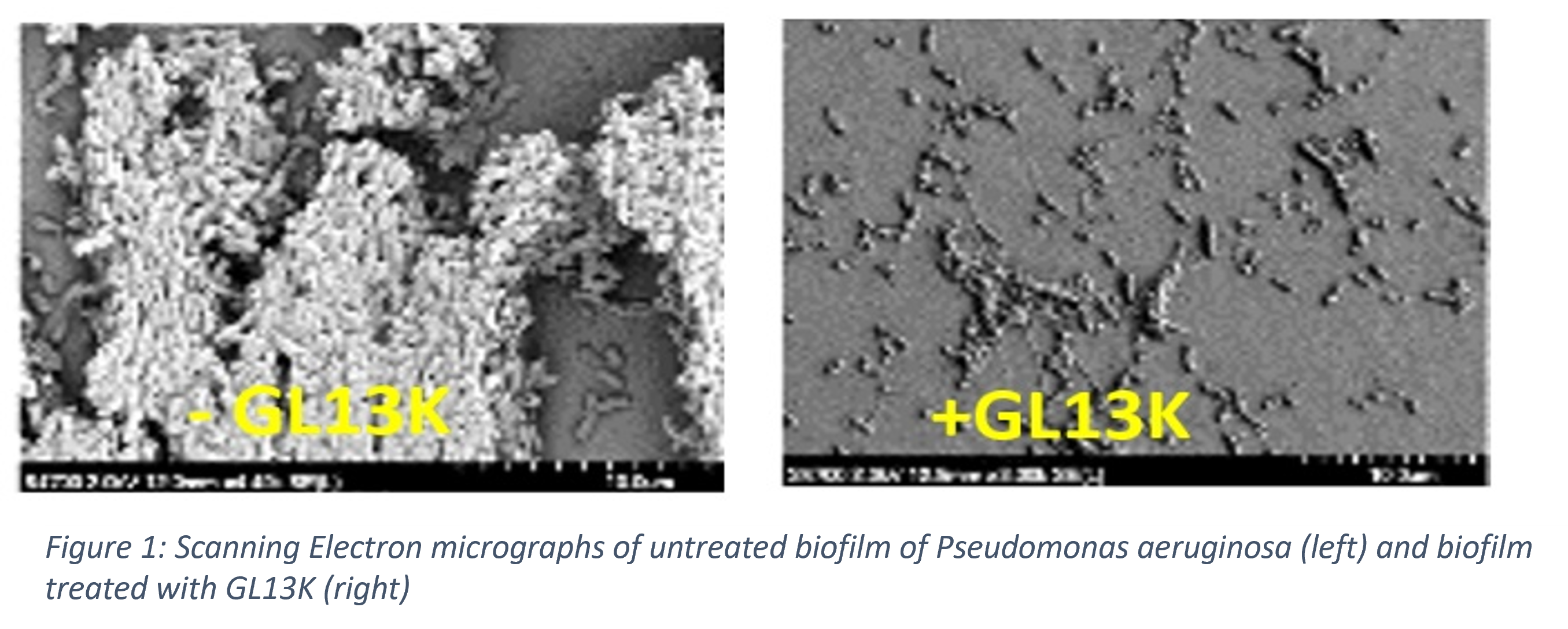Surface Coating with Novel Antimicrobial Peptide DGL13K
Family of antimicrobial peptides, based on the core peptide GL13, that directly attack the bacterial cell membrane.

Applications
- Novel peptide-based antibacterial therapeutic
- Treatment of chronic wound infections, oral infections and burn wound infections
- Prevention and treatment of bacterial biofilms
Key Benefits & Differentiators
- Broad antibacterial activity: GL13K acts against Gram-positive and Gram-negative bacteria and biofilms, in solution and as an implant coating
- Recalcitrant to resistance: GL13K does not cause de novo drug resistance
- Active against priority pathogens: GL13K has activity against Enterococcus, Staphylococcus, Klebsiella, Acinetobacter, Pseudomonas Escherichia, Streptococcus and Porphyromonas
- Low toxicity: GL13K peptide has low mammalian cell toxicity and low hemolytic activity
Technology Overview
Antimicrobial resistance is a significant global public health challenge associated with nearly 5 million deaths worldwide in 2019. An increasing number of infections including pneumonia, gonorrhea, hospital-acquired infections and foodborne illnesses are becoming difficult to treat due to antibiotic resistance. The economic costs of antibiotic resistance are enormous due to increased medical costs, long periods of hospitalization and increased mortality. In addition to judicial use of antibiotics, it is imperative to develop new, efficacious therapeutics, which do not cause new bacterial resistance.
Researchers at the University of Minnesota have developed a family of antimicrobial peptides, based on the core peptide GL13, which exhibit several desirable characteristics for a novel antibiotic. These peptides directly attack the bacterial cell membrane making them less susceptible to bacterial resistance. Briefly, in vitro studies of the D-enantiomer of GL13K showed that the peptide is effective against multidrug-resistant Pseudomonas aeruginosa, methicillin-resistant Staphylococus aureus (MRSA), vancomycin-resistant Enterococci (VRE), ESBL-producing Enterobacterales and carbapenem-resistant Enterobacterales (CRE) (1,3).
GL13K kills established biofilms (Fig. 1) and GL13K peptide coating of titanium implants and on dental tissues prevented biofilm formation (4,5) without impeding bone or dental tissue healing (6). In vivo studies in a mouse burn-wound infection model showed that DGL13K reduced infection (2) while increasing wound healing. Taken together, the GL13K peptide has desirable characteristics that make it suitable for development into an antibacterial therapeutic and surface coating.
Phase of Development
TRL: 3-5In vivo studies
Desired Partnerships
This technology is now available for:- License
- Sponsored research
- Co-development
Please contact our office to share your business’ needs and learn more.
Researchers
- Sven-Ulrik Gorr, PhD Professor,Department of Diagnostic and Biological Sciences
- Conrado Aparicio, PhD Professor, Department of Restorative Sciences
- Alex Fok PhD Professor, Department of Restorative Sciences
-
swap_vertical_circlelibrary_booksReferences (6)
- Hirt, H., Hall, J.W., Larson, E. and Gorr, S.U. (2018), A D-enantiomer of the antimicrobial peptide GL13K evades antimicrobial resistance in the Gram positive bacteria Enterococcus faecalis and Streptococcus gordonii, PLoS One
- Gorr, S.U., Flory, C.M. and Schumacher, R.J. (2019), In vivo activity and low toxicity of the second-generation antimicrobial peptide DGL13K., PloS one
- Gorr, S.U., Brigman, H.V., Anderson, J.C. and Hirsch, E.B (2022), The antimicrobial peptide DGL13K is active against drug-resistant gram-negative bacteria and sub-inhibitory concentrations stimulate bacterial growth without causing resistance, Plos one
- Moussa, D.G., Fok, A. and Aparicio, C. (2019), Hydrophobic and antimicrobial dentin: A peptide-based 2-tier protective system for dental resin composite restorations, Acta biomaterialia
- Ye, Z., Sang, T., Li, K., Fischer, N.G., Mutreja, I., Echeverría, C., Kumar, D., Tang, Z. and Aparicio, C. (2022), Hybrid nanocoatings of self-assembled organic-inorganic amphiphiles for prevention of implant infections, Acta biomaterialia
- Chen, X., Zhou, X.C., Liu, S., Wu, R.F., Aparicio, C. and Wu, J.Y (2017), In vivo osseointegration of dental implants with an antimicrobial peptide coating, Journal of Materials Science: Materials in Medicine
-
swap_vertical_circlecloud_downloadSupporting documents (1)Product brochureSurface Coating with Novel Antimicrobial Peptide DGL13K.pdf